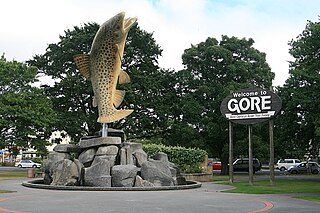
Gore is a town and district in the Southland region of the South Island of New Zealand.

Kaiapoi is a town in the Waimakariri District of the Canterbury region, in the South Island of New Zealand. The town is located approximately 17 kilometres north of central Christchurch, close to the mouth of the Waimakariri River. It is considered a satellite town of Christchurch and is part of the Christchurch functional urban area.
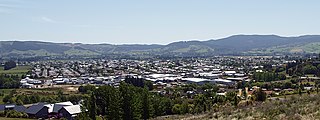
Mosgiel is an urban satellite of Dunedin in Otago, New Zealand, fifteen kilometres west of the city's centre. Since the re-organisation of New Zealand local government in 1989 it has been inside the Dunedin City Council area. Mosgiel has a population of approximately 14,500 as of June 2022. The town celebrates its location, calling itself "The pearl of the plain". Its low-lying nature does pose problems, making it prone to flooding after heavy rains. Mosgiel takes its name from Mossgiel Farm, Ayrshire, the farm of the poet Robert Burns, the uncle of the co-founder in 1848 of the Otago settlement, the Reverend Thomas Burns.

The Taieri River is the fourth-longest river in New Zealand and is in Otago in the South Island. Rising in the Lammerlaw Range, it initially flows north, then east around the Rock and Pillar range before turning southeast, reaching the sea 30 kilometres (19 mi) south of Dunedin.
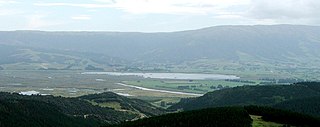
The Sinclair Wetlands are an internationally renowned wetlands located to the south west of Dunedin, New Zealand, at the southern edge of the Taieri Plains. They are on the western side of Lake Waipori and approximately equidistant between Mosgiel and Milton. The protected area covers a little over 315 Ha 3 km2.

Glen Williams is a hamlet in Halton Hills, Halton Regional Municipality, Ontario, Canada. It has a population of about 2700 people and its closest neighbours are Georgetown and Terra Cotta.

New Zealand Parliament Buildings house the New Zealand Parliament and are on a 45,000 square metre site at the northern end of Lambton Quay, Wellington. They consist of the Edwardian neoclassical-style Parliament House (1922); the Parliamentary Library (1899); the executive wing, called "The Beehive" (1977); and Bowen House, in use since 1991. Whilst most of the individual buildings are outstanding for different reasons, the overall setting that has been achieved "has little aesthetic or architectural coherence".
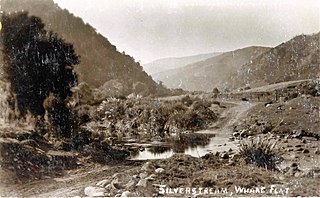
The Silver Stream is a small river flowing close to the town of Mosgiel in Otago, New Zealand.

The Leeds Industrial Museum at Armley Mills is a museum of industrial heritage located in Armley, near Leeds, in West Yorkshire, Northern England. The museum includes collections of textile machinery, railway equipment and heavy engineering amongst others.
The following lists events that happened during 1821 in New Zealand.
Arthur John Burns was a prominent early settler of Otago, New Zealand, a member of the Otago Provincial Council, a member of the New Zealand House of Representatives and founder of the Mosgiel Woollen Company, Dunedin.

Edward Jollie was a pioneer land surveyor in New Zealand, initially as a cadet surveyor with the New Zealand Company. The Christchurch Central City is laid out to his survey.

Queen Street Mill is a former weaving mill in Harle Syke, a suburb to the north-east of Burnley, Lancashire, that is a Grade I listed building. It now operates as a museum and cafe. Currently open for public tours between April and November. Over winter the café is opened on Wednesdays. It is also viewable with private bookings.
Elizabeth Turnbull was a New Zealand woollen mill worker and centenarian. She was the head of her section in the hosier department at Mosgiel Woollen Mill.
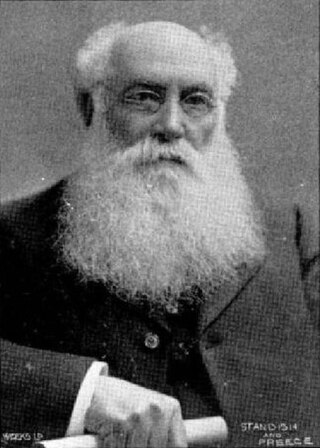
Samuel Charles Farr was a 19th-century builder and architect in Christchurch, New Zealand. He intended to emigrate from England to Auckland, but significant shipping problems saw him end up in Akaroa in 1850 instead. From 1862, he lived in Christchurch. Farr has a number of firsts against his name: the first marriage in Canterbury, he designed Akaroa's first church, designed New Zealand's first iron verandahs, and he started Sunday schools in Canterbury. As a leading member of the Acclimatisation Society, he stocked almost every lake and river in Canterbury with fish and was instrumental in introducing the bumblebee to New Zealand. His most notable building was Cranmer Court, the former Normal School, in the Christchurch Central City; this building was demolished following the February 2011 Christchurch earthquake.

Dunedin Gasworks Museum is located in South Dunedin, in the South Island of New Zealand. It is one of only a few known preserved gasworks museums in the world.
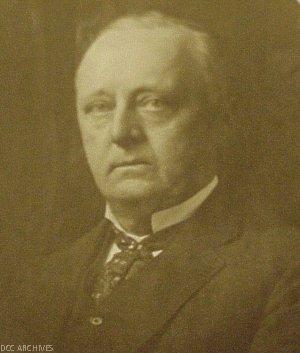
Sir John Roberts founder and managing partner of Murray Roberts & Co was a leading New Zealand businessman and run-holder of the last quarter of the 19th century and the first quarter of the following century.

The woollen industry in Wales was at times the country's most important industry, though it often struggled to compete with the better-funded woollen mills in the north of England, and almost disappeared during the 20th century. There is continued demand for quality Welsh woollen products.

The Wingatui railway station, sometimes known as the Wingatui Junction railway station, is a former station between Dunedin and Mosgiel in Otago, New Zealand. On the Main South Line, it is the junction for the Otago Central Railway
Manufacturing in New Zealand contributed $23 billion (12%) of the country's gross domestic product and directly employed 241,000 people in 2017, while manufactured goods made up 52% of the country's exports by value. The food and beverage subsector alone contributed 32% of manufacturing's GDP and 71% of exports.

















